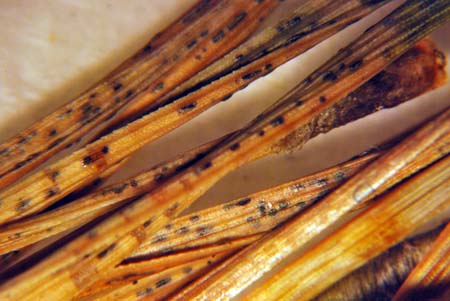Brown spot needle blight symptoms are showing up in Scots pine
Browning and early needle loss caused by brown spot needle blight is showing up on infected Scots pine, making Christmas trees unsalable.

Brown spot needle blight (Mycosphaerella dearnessii, syn. Scirrhia acicola) was first reported in Michigan in the fall of 2010. The symptoms of brown spot needle blight infection are now beginning to show up in Scots pine Christmas trees. On trees that have been severely infected, only the very top of the tree may still be green.
The fungus causes two kinds of needle spots. These can appear on needles at any time of the year, but most commonly during August and September on Scots pine. If you look closely at last year’s foliage, you will find reddish-brown, resin-soaked spots with yellow margin on green needles. On brown needles, you will find numerous black fruiting bodies.
Short-needled Scots pine varieties such as Spanish and French-green are more susceptible to fungal attack than the long-needled varieties. Brown spot can be controlled by fungicidal sprays. Apply the first application when the new needles are about half-grown (May-June) and a second spray three to four weeks later. Shorten the spray interval in rainy conditions. Several products with chlorothalonil or mancozeb are labeled for control.

Black fruiting bodies on dead needles. Photo by Jan Byrne, MSU Diagnostic Services.
Michigan State University Extension advises adjusting your shearing practices to avoid moving spores into other plantations:
- Do not shear infected trees during wet weather because spores released at this time may be carried from tree to tree, on workers’ clothes or shearing tools.
- Sterilize tools after shearing affected plantations by dipping in denatured alcohol for three minutes.
- Shear healthy plantations first so pathogen spores will not be carried into them from affected plantations.



 Print
Print Email
Email


